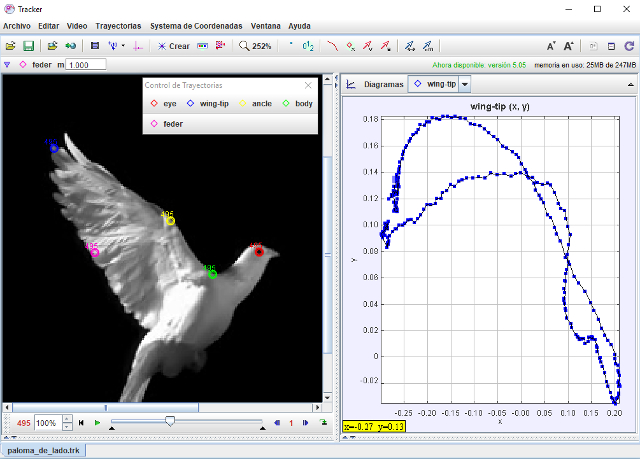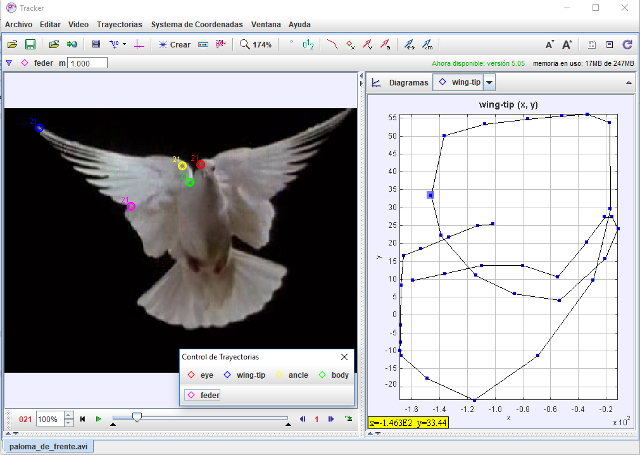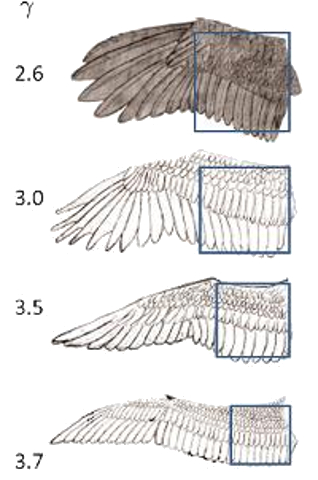Birds
Storyboard 
Birds have a very unique way of flying that sets them apart from the techniques used by humans in their aircraft. In this case, the wings serve a dual purpose, generating both lift and thrust, even when the bird is stationary.
Variables
Calculations
Calculations
Equations
As the power of flight ($P$) is related to the density ($\rho$), the total object profile ($S_p$), the coefficient of resistance ($C_W$), the body mass ($m$), the gravitational Acceleration ($g$), the proportionality constant coefficient sustainability ($c$), the surface that generates lift ($S_w$), and the speed with respect to the medium ($v$) through
with the definitions of the surface that generates lift ($S_w$) in terms of the wing width ($w$)
and the aspect Ratio ($\gamma_w$)
along with the aircraft body mass ($m_p$) in relation to the wing height ($d$)
and the thickness to span ratio ($\gamma_d$)
finally, as
Examples
If you study the video of a pigeon flying from a lateral perspective, you can observe how it advances and retracts its wings.
During the forward phase, the bird manages to generate lift, while during the backward phase, it seeks propulsion.
If you study the video of a pigeon flying from a frontal perspective, you can observe how it extends and retracts its wings.
During the forward phase, the bird extends its wings for the first time to generate lift, while during the backward phase, it extends them for the second time to propel itself forward.
To model the wing, we need to estimate the wing span ($L$), the width the wing width ($w$), and the wing height ($d$) of the wing in order to calculate the surface that generates lift ($S_w$) and the total object profile ($S_p$). An article with data for migratory birds can be found in [1]:
| Bird | $m$ [kg] | $S_w$ [m2] | $L$ [m] | $\Delta$ [m] |
| Stonechat | 0.0232 | 0.01366 | 0.264 | 0.052 |
| Meadow Pipit | 0.0199 | 0.0143 | 0.273 | 0.052 |
| Nightingale | 0.0197 | 0.01059 | 0.221 | 0.048 |
| Barn Swallow | 0.0182 | 0.01446 | 0.328 | 0.044 |
| Robin | 0.0182 | 0.01026 | 0.224 | 0.046 |
| Yellow Wagtail | 0.0176 | 0.01051 | 0.248 | 0.042 |
| Spotted Flycatcher | 0.0153 | 0.01209 | 0.262 | 0.046 |
| Black Redstart | 0.015 | 0.01006 | 0.200 | 0.050 |
| Garden Warbler | 0.0123 | 0.00779 | 0.200 | 0.039 |
| Pied Flycatcher | 0.012 | 0.00873 | 0.200 | 0.044 |
| Serin | 0.0114 | 0.00828 | 0.214 | 0.039 |
| Garden Warbler | 0.0087 | 0.00768 | 0.194 | 0.040 |
| Goldcrest | 0.0054 | 0.00504 | 0.146 | 0.035 |
Note: In this case, wing areas and spans are provided, so the width can be estimated as $S_w/L$. Similarly, the wing height can be estimated from the profile area divided by the span $S_p/L$, although in this case, we are not considering that the profile includes the bird's body section.
[1] "Field Estimates of Body Drag Coefficient on the basis of dives in passerine Birds," Anders Hedenstr m, Felix Liechti, The Journal of Experimental Biology, 204, 1167-1175 (2001).
When we compare different types of wings, we notice that raptors tend to have shorter and broader wings, whereas migratory birds have longer and narrower ones. Therefore, it makes sense to define the aspect Ratio ($\gamma_w$) as the relationship between the wing span ($L$) and the wing width ($w$):
The surface that generates lift ($S_w$) can be estimated using the wing span ($L$) and the wing width ($w$) as follows:
The total object profile ($S_p$) can be estimated using the wing span ($L$) and the wing height ($d$) as follows:
The aspect Ratio ($\gamma_w$) is defined as the ratio between the wing width ($w$) and the wing span ($L$), indicating the proportion or relationship between these two variables:
The aspect Ratio ($\gamma_w$) can be defined as the thickness to span ratio ($\gamma_d$), which relates the wing width ($w$) to ERROR:6338
Just as the power of flight ($P$) is related to the density ($\rho$), the total object profile ($S_p$), the coefficient of resistance ($C_W$), the body mass ($m$), the gravitational Acceleration ($g$), the proportionality constant coefficient sustainability ($c$), the surface that generates lift ($S_w$), and the speed with respect to the medium ($v$) through
we can express the power in terms of the aspect Ratio ($\gamma_w$) and the thickness to span ratio ($\gamma_d$) as
ID:(2056, 0)



